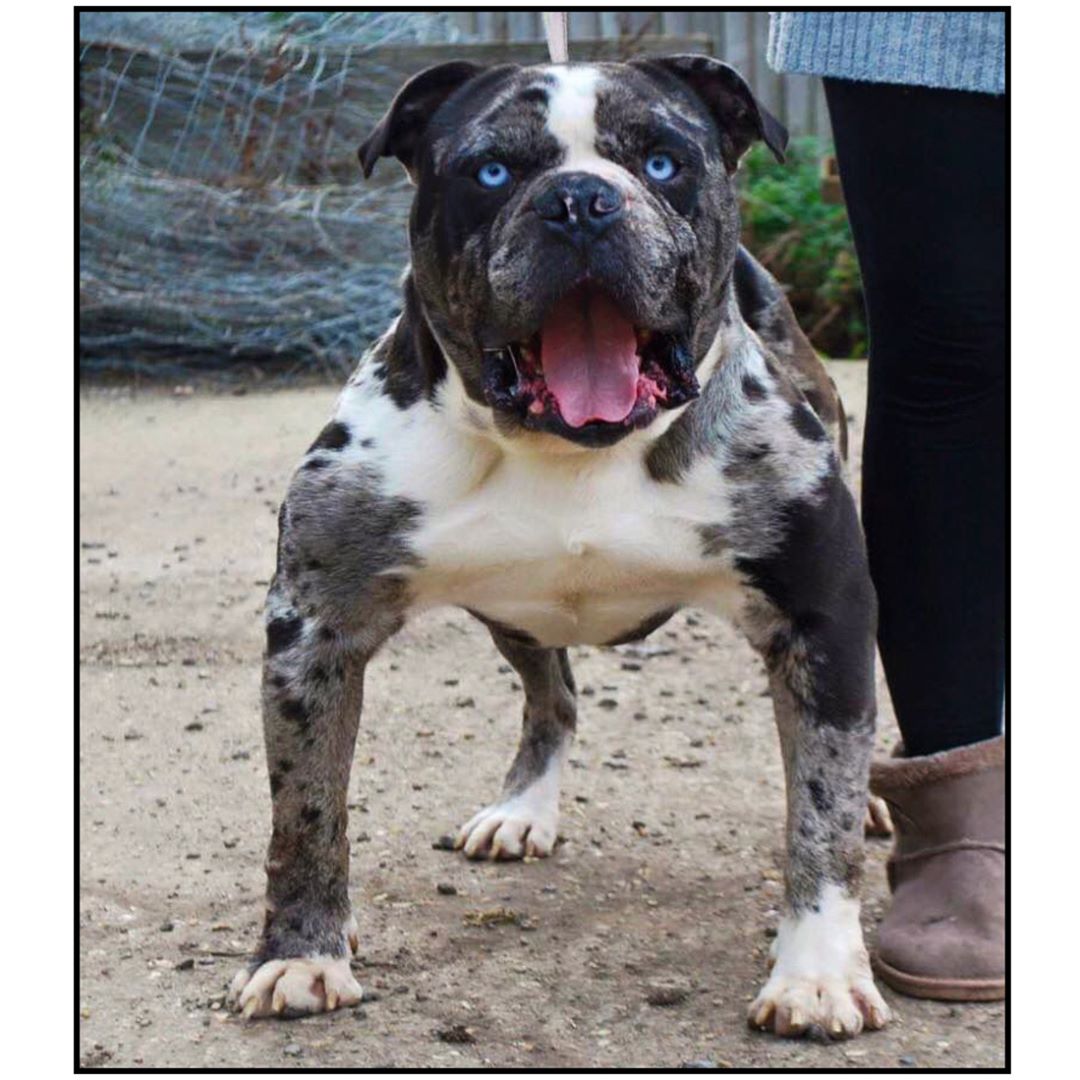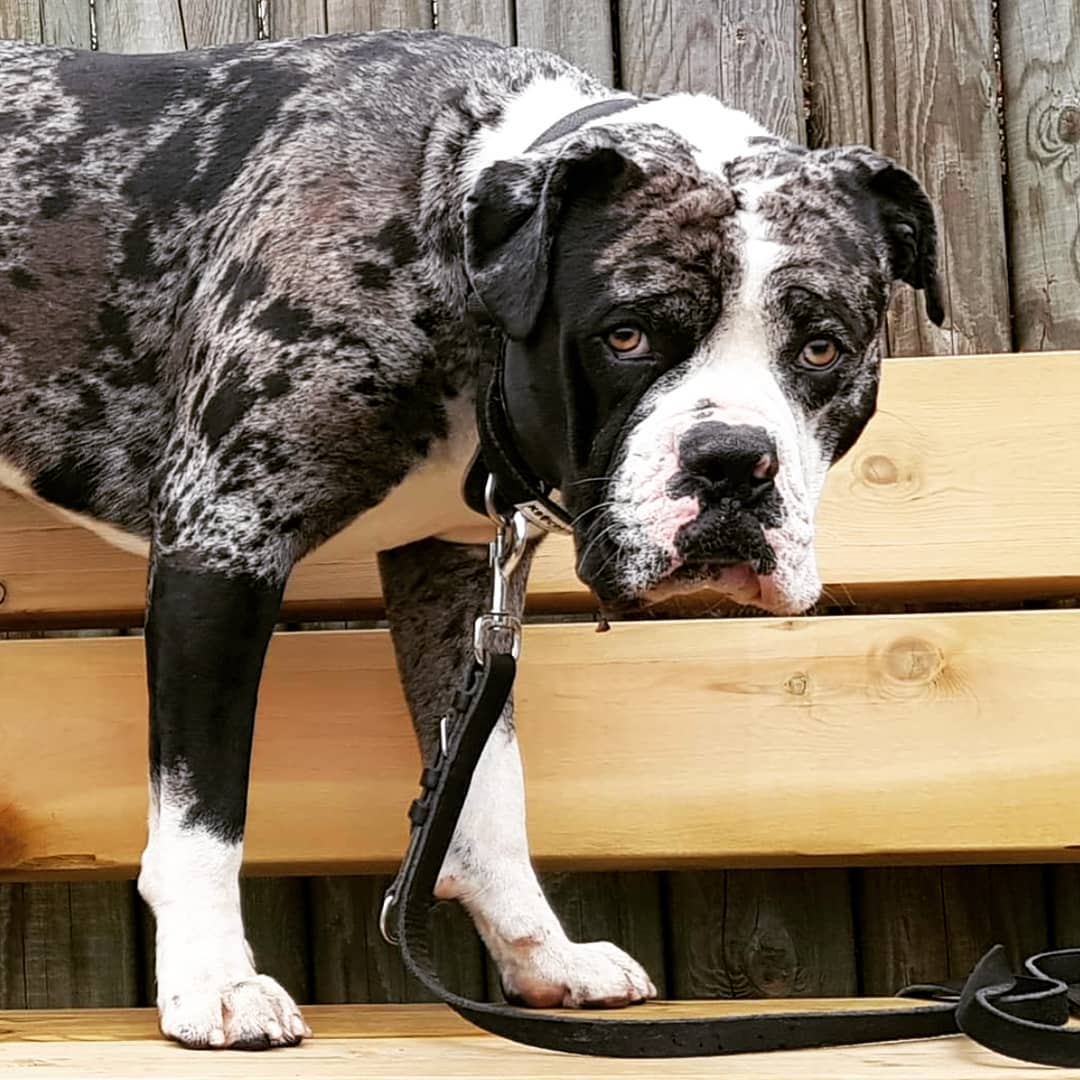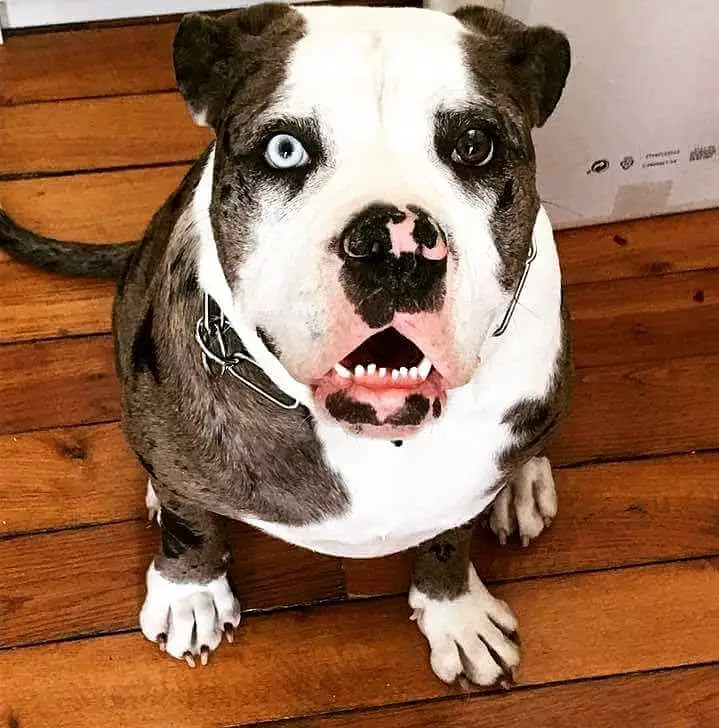The Alapaha Blue Blood Bulldog is an ideal animal for those who like a dog that is both pet and guard dog for their home. If you are interested in this canine and would like to know more about its history, traits, and health, then read the article below.
What is an Alapaha Blue Blood Bulldog?

The Alapaha Blue Blood Bulldog is a large dog breed that is said to resemble the earliest versions of England’s Bulldogs. Some people think that the Alapaha Blue Blood Bulldog existed for 200 years in the United States, but there is no record or documentation of the canine before 1979. Regardless of the lack of historical verification, there is a significant possibility of a dog’s ancestors (Mountain Bulldog, Old Country Bulldog and Old Southern White) were brought by settlers who arrived in the Southern part of the United States.
The original breeds were unaccustomed to the South’s humidity and heat; hence they were crossbred with local mastiffs and curs to create a hardier specimen. The new hardier canines worked as plantation dogs working to hunt vermin, guard the plantation homesteads and act as cattle drivers.
The American Civil War caused a disruption that almost drove the Alapaha dog breeds to extinction. A few farmers were determined and stubborn enough to preserve the remaining Alapaha Bulldogs.
But the most famous of these farmers was Buck Lane who lived in the town of Rebecca in Georgia. Using his favorite dog Otto (thus giving an alternate name to the canine breed) Buck Lane began a breeding program that resulted in several generations of dogs in which some took up the name Otto. Buck Lane died in 1943, but his granddaughter Lana Lou Lane took up the task of breeding the Alapahas until her death in 2001.
Official records of the breed started in 1979, and this is only due to a group of Southerners who founded the Alapaha Blue Blood Bulldog club to serve as a registry for the Alapaha breeds. The Lane family maintained the Alapaha breeding program for more than a century and thanks to their efforts, the dog survived and is now a family pet.
The breed’s name comes from the Alapaha River which is the Suwanee River’s tributary and is near Rebecca the town where Buck Lane resided. The word “blue blood” in the dog’s name is from Buck Lane himself who believed that the animals represent a noble (aka blue-blooded) breed.
The Appearance of the Alapaha Blue Blood Bulldog
An Alapaha Blue Blood Bulldog is a large canine with a height of 20 to 24 inches at the shoulders for males while females are 18 to 22 inches at the shoulders. Since the Alapaha is a large animal, its weight is at 70 to 90 pounds for males and females weigh at 55 to 77 pounds.
The Alapaha Blue Blood Bulldog breed has an athletic look with a medium-sized, form. The animal’s power-packed body has no excessive bulk, and it gives you the impression that it possesses determination, energy and great strength. Lastly, the Alapaha has a strong and powerful-looking jaw that is the common trait of any Bulldog breed.
The animal has a short smooth coat which makes any grooming you do on this dog relatively easy. The coat has blue, red or brown merle colors that are striped in white or chocolate-white color.
Pictures and Video





Alapaha Blue Blood Bulldog Temperament
Despite the Alapaha Blue Blood Bulldog‘s physical and intimidating looks, the canine is a family-friendly all the way. Due to the breed’s origin as a working canine, the Alapaha is dutiful, obedient, loyal and protective of its home as well as family. The dog’s attachment to you and your family is strong indeed and in fact if you leave the canine alone for long periods of time it will suffer from separation anxiety. A pet that suffers from separation anxiety tends to be mentally upset and have destructive behavior. This breed also gets along with children, but you or any adult may have to oversee any interactions between them. Alapaha’s won’t hurt a kid, but it can do so by accident.
Despite being companion dogs nowadays, the Alapaha Blue Blood Bulldog still retains it possessive nature and ever alert for threats to you and your home. These traits make the animal an excellent guard and watchdog. Additionally, an Alapaha’s attitude towards unfamiliar people is reserved and wariness. Other dogs and pets do not get along with the Alapaha due to their territorial trait unless it has been socialized.
Health Issues
The Alapaha Blue Blood Bulldog suffers from various health problems, and it’s not alone in this situation since every dog breed has them as well. Nonetheless, an Alapaha is relatively healthy. Still, you need to know the various problems that can affect your pet so that you can prepare and deal with them.
- Congenital Deafness – A genetic disease that affects at least 80 dog breeds. The breeds that are affected by congenital deafness are those with white coats that have spots, merle or dapple. These particular dogs (which the Alapaha is part of) are predisposed to have this problem. Other causes of congenital deafness are not genetic
- Entropion – This particular disease affects your pet’s eyes by inverting or folding inward the eyelids. The result of entropion is the perforation or corneal ulceration of the eye due to the dog’s hair or eyelash irritating and scratching the eyes’ surface. Entropion is a common affliction in dogs of different breeds especially the short-nosed, sporting, and giant breeds. The facial shape of a canine is one cause of entropion, and other causes include repeated bouts of eye infections, various types of eye irritants, severe loss of weight and inflammation of the chewing muscles. Mucus discharge, cornea inflammation along with rupture and excess tears are symptoms of entropion.
- Hip Dysplasia – A type of skeletal-related disease that is a common health issue in dogs. Hip dysplasia affects your pet’s hip joint or to be more specific the ball and socket joints. Under normal circumstances, the ball portion of the joint smoothly slides into the socket. Should malformation occur, the ball portion grinds and rubs against the socket instead of sliding smoothly into it. Hip dysplasia is genetically acquired, but environmental factors, obesity or rapid weight gain, nutritional factors, and the pelvic muscle mass also contribute to the appearance of it. Symptoms of hip dysplasia are the loss of mass in the thigh muscles, hip joint pains, swaying gait or bunny hopping, difficulty in rising, decreasing physical activity, the lameness of the hind legs and reluctance to do physical exercises.
In addition to these health issues above, dogs can also suffer from allergies due to food (especially food that is not suitable for dogs), environmental allergens or fleas. Alapaha Blue Blood Bulldog breed has a lifespan of 12 to 15 years.
Must Read:
- Nutritional Requirements and Best Dog Food for Bulldogs
- Comfortable Harness for Pitbull and Other Bully Dog Breeds
- Lovable and Adorable Bully Canine Breeds
- The Incredible Family Dog – American Bully
Training and Exercise
Keeping your Alapaha Blue Blood Bulldog pet healthy and teaching it some discipline is vital to the dog’s overall development.
Once you have your own Alapaha Blue Blood Bulldog treats, toys, meals and play for successfully doing your commands as well as training exercises. Positive reinforcements and praises in training should make your pet more responsive and successful in its endeavors.
Socialization goes hand in hand with training and is also necessary. It is true that Alapahas are excellent watch and guard dogs, but they need to recognize and sort out what is normal and constitutes as a threat. Socializing your pet is relativity easy, and all you have to do is take the dog along with you. Whether you are visiting friends or relatives, going out shopping or taking a walk, you can take your Alapaha with you. In time the dog or puppy will get used to the sight and sounds of every day instead of treating them as potential threats. You can do this same method when it comes to socializing your dog with other pets.
An Alapaha dog is a moderately active animal hence it needs some exercise. If you are fond of doing daily exercises of your own, then bring your pet along. Outdoor activities are alternatives to Alapaha owners who don’t have a backyard with a fence. An Alapaha needs 20 minutes’ worth of daily jogging or walking at a minimum of one mile. Don’t forget to leash your dog first before going out. Daily walks and jogging go hand in hand with socialization training.
FAQS About Alapaha Blue Blood Bulldog
Living with Alapaha Blue Blood Bulldog
Owning an Alapaha Blue Blood Bulldog or any dog breed for that matter will necessitate some changes in your home and family. The Alapahabut it can be a difficult animal for the first-time owner. If this is your first time in owning an Alapaha
From day one, the owner or you should establish who is the leader in your household. Alapaha has the personality to be dominant, and unless you show yourself to be decisive and firm, they will be asserting their dominance.
Spending time with your Alapaha is a must since the dog is eager for attention. Separation anxiety can significantly affect an Alapaha, and it has adverse effects on its mental state. Boredom is something that your dog must avoid. Alapaha’s that get bored tend to develop destructive behavior such as unnecessary digging or chewing your stuff like shoes, furniture, etc. Playing with your Alapaha should mitigate its boredom.
Where Can I Find an Alapaha Blue Bulldogs?
Knowing where to get an Alapaha Blue Blood BulldogIf you wish to adopt one, you need to find the right place. Here are some tips to get a start on your search:
- Search online – Today the internet is a boon to those wanting to find things the easy way. Social media like Facebook is one online venue you can search. Alternatively, you can check the newspapers classified ads.
- Talk to the local experts – There are bound to several pet pros in your local area or at the very least in a neighboring city or town. You can also find several breed clubs who have contacts of knowledge of rescue organizations for homeless dogs.
- Ask people for recommendations – Perhaps you know someone who knows the right place to adopt dogs. If that’s the case, you ask the person for the location or name.
To look for specific places for adopting a dog, these sites below will be of some help to you:
- AnimalShelter – This site has a list of animal rescues whether in your area or others.
You can also inquire among dog clubs to help in your search. Here is a list of them:
- Alapaha Blue Blood Bulldog Association
- The American Canine Association, Inc. (ACA)
- America’s Pet Registry (APRI)
- Animal Rescue Fundraising Club (ARF)
- World Wide Kennel Club, Ltd. (WWKC)
- Dog Registry of America, Inc (DRA)
The Alapaha Blue Blood Bulldog price is between $800 – $1200. The price tag is high no doubt about it, but it is more or less an indication that the puppy is legit and high-quality.
How to Choose Alapaha Blue Blood Bulldog Breeders?
There are many Alapaha Blue Blood Bulldog breeders and selecting the right one can be a challenging task for you. Here is some basic advice when looking for an Alapaha breeder:
- Dog breeders have online sites, and anyone can check out those sites. A search engine should the results, and it’s up to you to browse the site.
- Try asking from your acquaintances in social media especially the ones that have dogs as pets.
- Steer clear of breeders selling puppies online directly. Direct selling and advertising puppies are two different things.
- The breeder will do his or her best to find the right puppy for you.
- At the same time, the breeder will try to ensure that you are giving the puppy a good home.
- The puppy must have all the necessary documents for health, pedigree, etc. available to you.
- A breeder will welcome any question concerning the pup’s personality, health, history, etc. and will answer your questions satisfactorily.
- Observe the puppy’s behavior and make a note of the state of the kennels.
If you find the prices of an Alapaha Blue Blood Bulldog breeder out of your price range, then adoption is your next choice. However, do not buy a puppy from puppy mills and pet stores no matter how low their prices.
Are Alapaha Blue Blood Bulldogs Aggressive or Safe?
Admittedly, the Alapaha Blue Blood Bulldog‘s size and looks coupled with its powerful-looking jaw look intimidating. There is news of the breed attacking and in some cases killing their owner. So is the Alapaha an aggressive animal or not?
The context as well as the whole story of these kinds of attacks matters. The aggressive Alapahas are products of unethical breeders who fail to breed out the aggressive trait of the breed and sell them to unsuspecting buyers. Some of Alapahas may have been abused or treated cruelly by their master hence them becoming aggressive.
There Alapaha dog attacks highlight the necessity of strictly breeding the dog right and buying from breeders that have legitimate credentials. The sooner the unethical breeders are put out of business, the better the dogs’ good reputation is restored.
Conclusion
The Alapaha Blue Blood Bulldog began its existence as a working dog that nearly got extinct. But thanks to the efforts of Buck Lane, the breed was saved, and now we have a pet companion that is loyal and friendly. Alapaha Blue Blood Bulldog. With an Alapaha’s protective nature gives you a dog that will guard your family and home.






